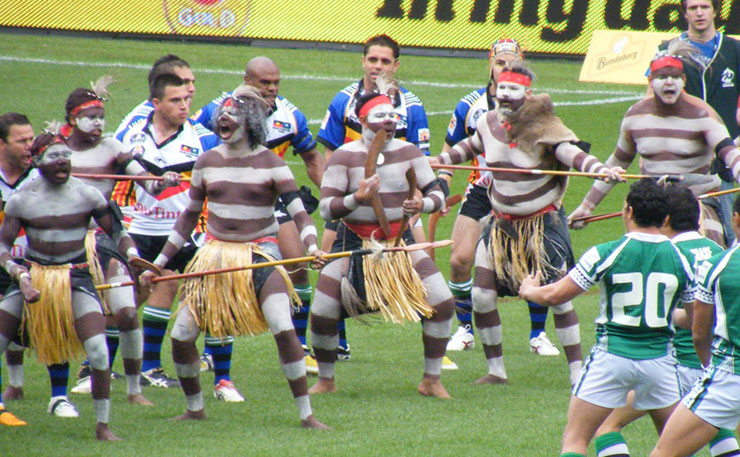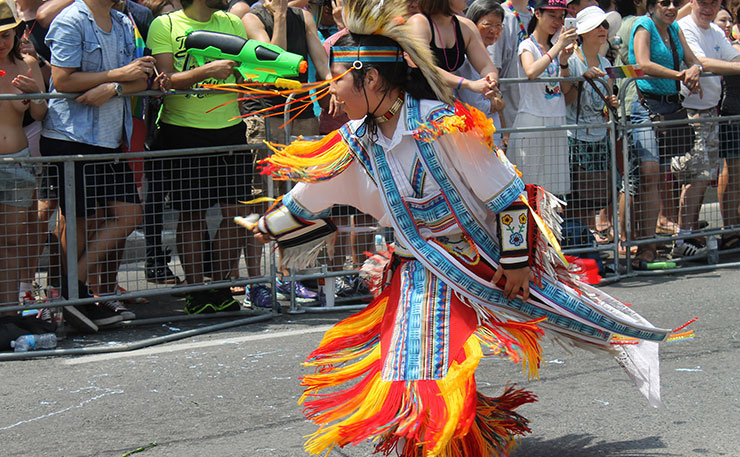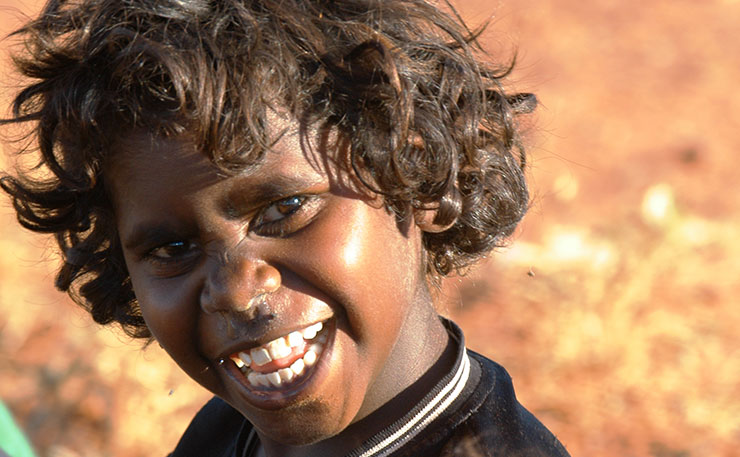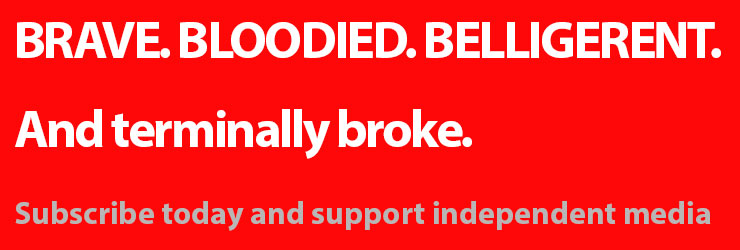Treaty, yeah! Treaty now! Liam McLoughlin makes the case for supporting a treaty with the mob.
In 1832, Governor of Van Diemen’s Land, George Arthur, said it was a “fatal error… that a treaty was not entered into” with Aboriginal people. In 2016, Opals star Alice Kunek used blackface to testify to the truth of Arthur’s words.
As discussed in a column last week, institutional racism from governments and the media trickles down and manifests in the ignorant, disrespectful and racist attitudes and actions of the broader Australian community.
It follows that the best way to end this tedious and damaging cycle of racism scandals is to tackle institutional racism.
That’s tops, but what’s the path to reducing institutional racism?
Well, if white Australia took off the blindfold, earmuffs and doona and actually listened to black Australia for the first time in history, the answer would be bleeding obvious: Treaty.
Treaty has been a clarion call from Indigenous communities and their allies for decades.
In 1979, the Aboriginal Treaty Committee was formed to educate and convince non-Indigenous Australians about the value of a Treaty.
In 1982, the National Aboriginal Conference proposed each Aboriginal nation sign its own treaty.
In 1988, the Chairmen of the Northern and Central Land Councils, Galarrwuy Yunupingu and Mr Rubuntja, presented The Barunga Statement to Prime Minister Bob Hawke. It called for the recognition of “a Treaty recognising our prior ownership, continued occupation and sovereignty and affirming our human rights and freedom”. In response, Hawke promised a Treaty by 1990.
In 1991, in collaboration with Paul Kelly and Midnight Oil, Yothu Yindi released “Treaty” to protest the failure of Hawke to honour his promise. The song became wildly popular, rising to number 11 on the Australian singles charts.
In 2000, the Council for Aboriginal Reconciliation described a Treaty as the unfinished business of the reconciliation process. A poll showed 53 per cent of Australians favour a Treaty, with only 34 per cent opposed.
In 2010, the UN Committee on the Elimination of Racial Discrimination recommended the government “consider the negotiation of a treaty agreement to build a constructive and sustained relationship with Indigenous peoples”.
More recently, a variety of Aboriginal leaders have repeated calls for a Treaty. These calls were crystallised in an online campaign launched by a group called Concerned Australians in 2014. In the feature video, Aboriginal actress Kylie Belling says, “We are Sovereign peoples, who have never ceded our land. We want to take control over our lives and determine our futures, through legal agreements, compacts, covenants or treaties established in law and enforceable through the courts.”
Treaty, yeah! But what is it exactly?
With insistent demands for a Treaty over many decades, you may be wondering a couple of things.
First of all, what is it?
Professor George Williams has clearly described a Treaty as an agreement between governments and Indigenous peoples which would involve three things:
1. A starting point of acknowledgement
Williams writes: “A treaty about such matters could recognise the history and prior occupation of Aboriginal people of this continent, as well as their long-standing grievances.”
2. A process of negotiation
Williams continues: “It could also be a means of negotiating redress for those grievances and helping to establish a path forward based on mutual goals, rather than ones imposed on Aboriginal people. At the heart of the idea is the notion that a place in the Australian nation cannot be forced on Aboriginal people. It needs to be discussed and negotiated through a process based on mutual respect that recognises the sovereignty of Aboriginal people.”
3. Outcomes in the form of rights, obligations and opportunities
Journalist and activist John Pilger has said a Treaty is “an effective Indigenous bill of rights: land rights, resources rights, health rights, education rights, housing rights and more.”
Kamilaroi woman Natalie Cromb weaves these three elements together nicely in her explanation of a Treaty: “A Treaty would be the basis upon which the sovereign Indigenous people of Australia and the government could negotiate the terms of rights to land, minerals and resources and the self-governing of communities.”
Treaty, yeah! But why is it so important?
Across the world treaties are common frameworks mapping out relations between Indigenous and non-Indigenous peoples.
The US, Canada and New Zealand all signed treaties with First Nations peoples and though flawed, they recognise Indigenous sovereignty, offer measures of redress, and set terms for coexistence.
In fact, Australia is the only Commonwealth country without a Treaty with its First Peoples.
Without such an agreement, when created, our constitution could easily ignore and exclude First Nations peoples.

It was adopted in 1901 at a time when Indigenous people were still being massacred. It is premised on genocide and the idea Aboriginal people were a ‘dying race’, so they were excluded.
Despite some advances in the 1967 referendum, our constitution still ignores the existence of Indigenous Australians, says people can be denied the vote because of their race, and says laws can be passed to discriminate based on race.
As editor of New Matilda Chris Graham has written, the fact that Australia “actually has to ‘debate’ the merits of removing racially discriminatory powers from its founding document speaks volumes about us as a people. It begs the question: why would a nation which claims to respect basic human rights need constitutional powers to discriminate on the basis of race?”
When the constitution is so thoroughly racist and when the gap between Indigenous and non-Indigenous Australians on every life indicator is so large, the need for radical change is obvious.
There are very good reasons to think, combined with making the constitution a whole lot less racist, a Treaty recognising Indigenous sovereignty would significantly improve the lives of Aboriginal people.
In fact there’s even evidence to suggest it’s the only effective path.
The Harvard Project on American Indian Economic Development has conducted hundreds of studies over two decades into governance in Native American communities. The project’s key conclusions could hardly be starker:
“Sovereignty matters – when Native nations make their own decisions about what development approaches to take, they consistently out-perform external decision makers – on matters diverse as governmental form, natural resource management, economic development, health care and social service provision.”
And:
“…in a century of U.S. efforts to improve Indian economic and community conditions, Indigenous self-determination is the only policy that has broad, positive, sustained results. Nothing else has worked.”
In addition, research into outcomes for Indigenous peoples in Canada has found a clear link between self-determination, lower suicide rates and better overall health.

Australian Indigenous communities know the importance of self-determination. They’ve been saying so since invasion. Without respecting Indigenous sovereignty, without treating Aboriginal and Torres Strait Islanders as partners in the road to full social, economic and legal equality for all Australians, policies like Close the Gap are doomed to failure.
But maybe that’s the point.
The thoughts of senior researcher at the Jumbunna Indigenous House of Learning, Paddy Gibson, are worth considering here. He writes that the capitalist ruling class does not want “well funded, well-functioning Aboriginal-controlled organisations with a confident leadership, because of the role such organisations have played in building solidarity and fighting oppression. Instead they punish and blame the victim.”
But I digress.
A three-year research program here in Australia from the Gilbert and Tobin Centre of Public Law confirmed the value of a Treaty back in 2005:
“…the call for treaty has been an insistent one. Its main appeal is in putting negotiation front and centre in dealings between government and Indigenous peoples. It offers a process broad enough to address both the practical and the symbolic and, as a foundational document for a renewed society, it can speak to the past, present and the future.”
Treaty, yeah! But what do we do now?
So a Treaty seems pretty great. How can we get behind it?
I know the view from here looks grim. It’s hard not to despair for the state of the universe when 16 years ago 53 per cent of Australians wanted a Treaty and now 53 per cent of Australians are grabbing the shoe polish and saying “black people, am I right?”.
But that’s because Howard and Co went to great lengths to derail the beautiful momentum building behind treaty and reconciliation over the course of the 1990s. Thanks to Howard we went from this in the year 2000:
To this, in nine short years:
Waiting for our political leaders to debate a Treaty is futile. When both major parties are all for torturing babies in offshore prison camps, it’s unlikely they’ll be leading the charge for Indigenous sovereignty any time soon.
That’s not so bad though, because change always comes from the grassroots, not from so-called “national leaders”.
Even our most progressive politicians have taken their cues from the grassroots.
As argued by Solidarity activist Jean Parker in a piece called Whitlam’s Legacy and the Death of Social Democracy, it was worker, gender equality, anti-war and Indigenous land rights movements of the late 60s and early 70s which prepared the ground for Whitlam and his legendary agenda of social reform.
In more recent years, grassroots activists have been working tirelessly to advance the rights of Aboriginal and Torres Strait Islander people and repeat calls for a Treaty.
We’ve seen extraordinary dedication from these activists. Wiradjuri elder Jenny Munro started the Redfern Aboriginal Tent Embassy which, after 400 days, secured affordable housing for former residents of The Block.
Since January 2014, activist group Grandmothers Against Removals has been campaigning to expose the high rates of Aboriginal child removal in NSW.
Aboriginal communities in Western Australia have spearheaded the #SOSBLAKAUSTRALIA movement to stop the forced closure of Indigenous communities.
Stop the Intervention Collective Sydney has been working for years to repeal the NT intervention and struggle for Aboriginal self-determination.
At one of their events in 2015, Kamilaroi woman Natalie Cromb, Wiradjuri woman Amala Groom, Gurindji woman Brenda Croft and Amatjere woman Rosalie Kunoth-Monks, spoke passionately about the need for a Treaty.
Or this:
Allies of Indigenous communities have lent their support to such campaigns. Paddy Gibson has written about the importance of building alliances among workers:
“During the Moratorium for Black Rights in 1972 for example, building workers, wharfies, teachers and council workers went on strike to join the demonstrations. This industrial power of organised workers is the most powerful weapon for hitting back against the system.
Control over The Block in Redfern was won in 1972 by a campaign that included the Builder’s Labourers Federation, who placed a “green ban” on the site to stop it being taken over by developers.
Similar bans were placed on a number of mining projects opposed by Aboriginal people in this period, including an ACTU ban on work at the Nookanbah mine in WA in 1980, during mass blockades led by Aboriginal people.
Just as Aboriginal rights surged forward during a period of union militancy, the wind-back of many of the gains over the past two decades has occurred during a period of serious retreat by the union movement, with historically low levels of membership and strike activity.”
Activist groups like Solidarity do the important, difficult, and grinding work of helping to rebuild these kinds of allegiances.
Other allies, such as journalist John Pilger with the film Utopia, and Chris Graham with his work at New Matilda, consistently provide opportunities for Indigenous issues and voices to be heard.
It’s high time broader civil society also show solidarity with these activists and help build momentum behind insistent calls for a Treaty.
Treaty, yeah! The way forward
Wouldn’t it be wonderful if more mainstream public figures and left leaning media outlets lent their powerful platforms to campaign for a Treaty?
As Indigenous affairs editor at the Guardian Australia, Stan Grant could lend his persuasive writing and oratory skills to the campaign for a Treaty. Perhaps he could encourage the Guardian to run an official campaign on a Treaty, much like the Keep it in the Ground campaign on climate change.
The Saturday Paper and The Monthly could emblazon their front pages with calls for a Treaty.
Waleed Aly could write columns and dedicate segments of The Project to it, because clearly a Treaty is “something we should talk about”.
The Weekly could dedicate a whole episode to a Treaty and Charlie Pickering could interview powerful advocates like Rosalie-Kunoth Monks.
Tom Gleeson could have a genuinely “Hard Chat” with Indigenous Affairs Minister Nigel Scullion.
Getup! has an incredible supporter base they could mobilise behind a clear and creative campaign for a Treaty.
The Greens have made Treaty part of their policy platform and they could also make it the subject of powerful speeches from Green MPs like Adam Bandt and Scott Ludlam, the kind that seem to regularly go viral on social media. Such insistent advocacy could help drag Labor to the left on this issue.
Similar to the #LetThemStay movement, unifying grassroots campaigning with calls for a Treaty on national media platforms would create a high pressure environment which mainstream politicians could ignore only at their peril.
Australia has two alternatives. We can sit as bystanders as our political leaders continue their attacks on Indigenous Australia and a new Black and White Minstrel Show becomes the highest rating show on television.
Or we can say enough is enough and call for a Treaty.
Let’s show solidarity with Indigenous Australians and demand Treaty Now.
* One way to show solidarity is to attend a public forum on Treaty next week at the Redfern Community Centre. Following on from their “Women Speak Out For Treaty” event last year, Stop the Intervention Collective have organised a forum called “Time For Treaties: Men Speak Out For Treaty” at 6pm on Monday 14th March. Featuring Assembly spokesperson Yingiya Mark Guyula, Chair of NTEU A&TSI Policy Committee Terry Mason, barrister Tony McAvoy, Aboriginal advocate Tauto Sansbury and Founding Chairman of the Stronger Smarter Institute Chris Sarra, and facilitated by journalist Jeff McMullen, it’s set to be a passionate and stimulating discussion. Click here for the Facebook event or here for further details.
Donate To New Matilda
New Matilda is a small, independent media outlet. We survive through reader contributions, and never losing a lawsuit. If you got something from this article, giving something back helps us to continue speaking truth to power. Every little bit counts.





